Apple's Mac Pro - Upgrading CPUs, Memory & Running XP
by Anand Lal Shimpi on September 12, 2006 1:51 AM EST- Posted in
- Mac
Next we had to remove the fan assembly, which we did by first removing two of the hard drive sleds so we could gain access to the lone screw that holds the fan assembly in place. Then, with a flexible putty knife we pulled the edge of the assembly away from the case and attempted to pull it out. The fan assembly will pull straight out, although we've found that it's a very tight fit and wiggling sometimes helps as you pull it out.
The fan assembly is made out of plastic so be careful as you're doing this; you'll want to put pressure on the less flimsy parts of the assembly to avoid snapping/cracking anything. Also be careful not to put pressure on the heatsinks as the aluminum is very thin and will bend very easily.
With the fan assembly out take a moment to marvel at how large and heavy it is, and then put it aside as we need to get one more thing out of the way before we can unscrew the heatsinks. If you can get the memory cage out then this next step isn't necessary, but if you're like us and can't get the thing out then this next step will make removing the heatsinks a lot easier.
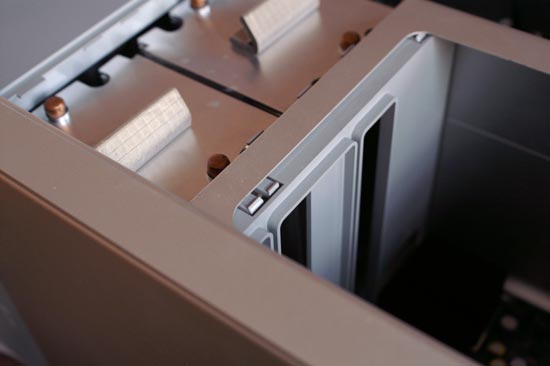
The plastic guard, pulled out slightly to expose the latches - Click to Enlarge
There's a plastic piece that sits in the left side of the memory cage; it's what the CPU heatsink cover latches on to on this side and it's also what helps the memory risers guide into place. This plastic piece can be removed fairly easily as it just latches into the memory cage itself, so break out the putty knife and let's get to it.
All you need to do is unlatch the plastic guard from the memory cage by sliding your putty knife between the cage and the guard. As you unlatch the plastic guard start pulling it away from the CPUs and eventually you'll get it off completely. Patience pays off here as you don't want to break any of the latches.
With the plastic guard off, it's now infinitely easier to gain access to the screws that hold the heatsinks in place. Each heatsink is attached to the motherboard by four allen screws; simply remove them (in an opposite side/opposite corner pattern) using a very long screwdriver (or a small allen wrench). We didn't have an allen wrench that worked so we attached two extenders to our screwdriver to get down to the screws.
With all of the screws undone for the first heatsink (the allen screws don't come off completely, they remain attached to the heatsink) you have to disconnect the thermistor cable that runs from the heatsink to the motherboard. Be sure to do this before you remove the heatsink as you don't want to cause any accidental damage to the cable.
Finally you lift off the heatsink and set it aside, exposing the LGA-771 Xeon socket below. You can repeat the process for the second heatsink, also not forgetting to remove its thermistor cable (this one is actually beneath the memory cage) before pulling off the heatsink. With both heatsinks removed, it was time to swap processors.


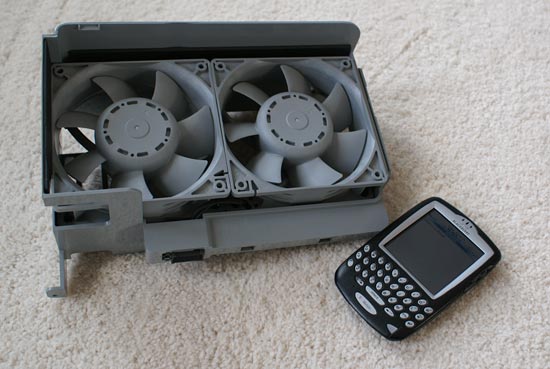
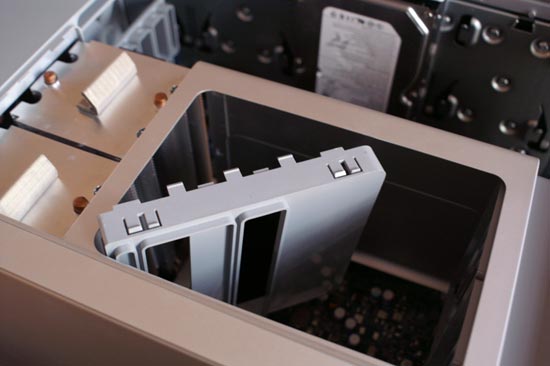
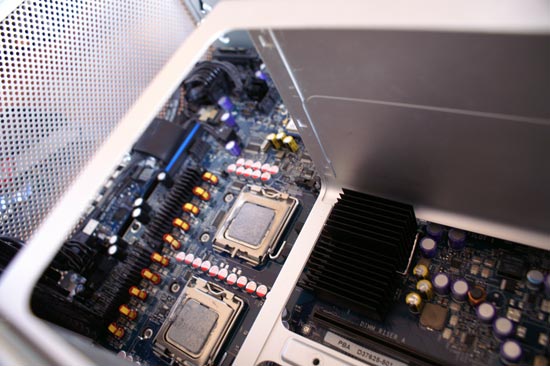
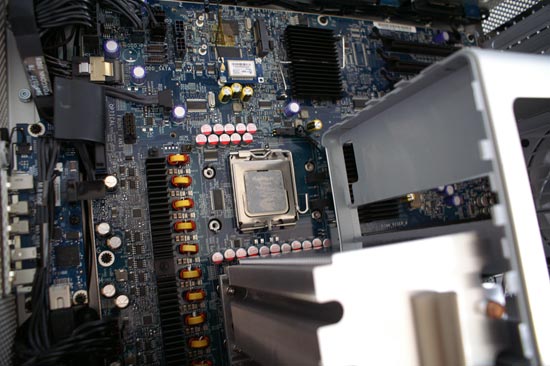
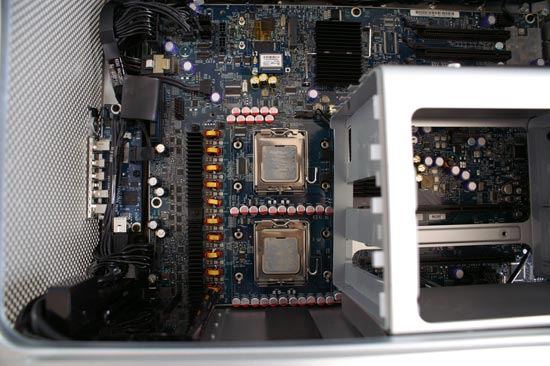








72 Comments
View All Comments
bobsmith1492 - Tuesday, September 12, 2006 - link
Well, thank you for the enlightenment. I will never use Vista now that I know I cannot use more than 64GB of RAM.blwest - Tuesday, September 12, 2006 - link
Who did that comment come from, something about never needing more than 64K? Was it Bill Gates?I already have customers that use Linux over MS because they utilize 64GB of ram TODAY. Even when Vista is released, they will still be using Linux.
bobsmith1492 - Tuesday, September 12, 2006 - link
Well, I've doubled the amount of ram in my _personal_ computer twice in about 5 years along with one upgrade of Windows (98-XP)... so, in 5 more, I'll have 8GB, 10 more: 32, and in about 12.5 years, I'll be up to 64GB, by extrapolation. :P Anyway, I don't expect Vista to last that long, so I guess I'm ok (heck, I'll use XP for a few more years anyway, no doubt - XP was out for a few years before I upgraded).As far as the 64GB of RAM, if you need that for your application, you probably wouldn't even dream of using a closed-source OS for it anyway, so I think the RAM limitation isn't really that relevant (maybe for servers...)
greylica - Tuesday, September 12, 2006 - link
Course the common user will not have to use that quantity of Ram, as far as I know, they are still using 256MB at nmaximun in order to run only apps for office/small production.Here in Brazil the most of them are using at maximun 512 MB of Ram, but when we think in a machine different, like a MAc, or then a graphic Workstation, or then an data seismic or a test evaluation machine, 64 GB in 5 years will be a cap, a limit.
Anyway Linux can save our souls to this switch Microsoft is trying to do again, and again...
A simpler crowd simulation in XSI can achieve 16 GB of Ram in a workstation...
Vista Premium can accept more than 4GB, course, but in the 32 bit usage, the same old 3GB switch is aplicable, but I don´t even imagine why they at the same tima reserve 4GB for the kernel, and limit Vista to 1/2 of the potential.
It´s a same old problem coming back again.
Even 2000 accepts PAE, but doesn´t serve for nothing, course they can give a patch, but, do they want ???
If a patch for ths issue is released, this topic can be sent to oblivion.
Microsoft, give us a patch to 3GB switch right now !!!!!!
mostlyprudent - Tuesday, September 12, 2006 - link
I have to agree with the first part of your post. I read the article and thought.."Why?". I have always understood the appeal of a Mac to be that you could upack it and get to work. If we start talking about running other OSs on a Mac or hacking software/drivers for better hardware supprt, then why pay the premium for a Mac?lopri - Tuesday, September 12, 2006 - link
Well, sort of.. Remember that now Mac is a PC with the ability to dual-boot between XP and OS X. Other than the anatomy description for CPU upgrading, I don't see anything Mac-specific about this article. You can replace the tested Mac with an equivalent workstation from Dell, HP, etc. and the end result would be the same. It's also very questionable how much appeal this article would have to an 'average' apple user - who wants a computer that just works, without worrying about upgrading or fixing, and prefers to use for creative works or entertainment. (This isn't my opinion, btw. I happened to read a few articles on Apple/Mac @DailyTech, and it's how Mac users described themselves) I totally understand this article is a sequel/finale to a previous article, but I think some people would agree with me. (If not, oh well.. :) )From this viewpoint, I'd like to make a comment that Anand's obsession on Apple (be it hardware or software) has been quite over-the-top already. Even though this article isn't really about something unique to Apple, he doesn't skip a single product that Apple produces. (I still can't believe he "reviewed" a mouse just because it's from Apple. There are many more superior and innovative mice in the market, you know.)
Whether it's his personal preference towards Mac/OS X or a business strategy to expand the readership of this site isn't clear to me. But I can't help but notice the imbalance and ask why.
Anand Lal Shimpi - Tuesday, September 12, 2006 - link
The point of the article was for users that want to run OS X as well as Windows XP, rounding out the performance comparison by showing what sort of XP performance you can expect out of the Mac Pro.As for our Mac coverage, we definitely don't review every Apple product that comes out, but the ones that we do focus on are those that are most interesting to the community. The vast majority of our content is still PC focused, but whenever there's a big Apple release we will do our best to cover it just as we do major releases on the PC side.
Take care,
Anand
JAS - Thursday, September 14, 2006 - link
PC = Personal Computer, regardless of whether it is running OS X or Microsoft Windows.Please continue with the Macintosh coverage, Anand. I appreciate the excellent work that you do, and even bought a Mac because of one of your reviews. What a fabulous computer.
Calin - Tuesday, September 12, 2006 - link
:)I'm sure Anand wants to expand the readership of his site to the 5% Mac users :)
(no offence, Anand) but I think this was more like a toy, that is getting better and better. "I bet I could use only this Mac for everything" could have been the idea of the first article, and in the end it seems the Macs were even better than that (whether by look and feel, ergonomy in user interface, invulnerability to almost all viruses/worms/... (the first Mac used by Anand was Power based), other reasons or a combination of all the above).
On another note, I wonder how well those new Macs will survive in the virus world, now that they now have the x86 processors
JAS - Thursday, September 14, 2006 - link
If you mean running Microsoft Windows on a Macintosh, then it is as susceptible to spyware and viruses as any other MS Windows computer. These problems are tied to the operating system, not the microprocessor. OS X is as secure running on Intel as it is on PowerPC chips.